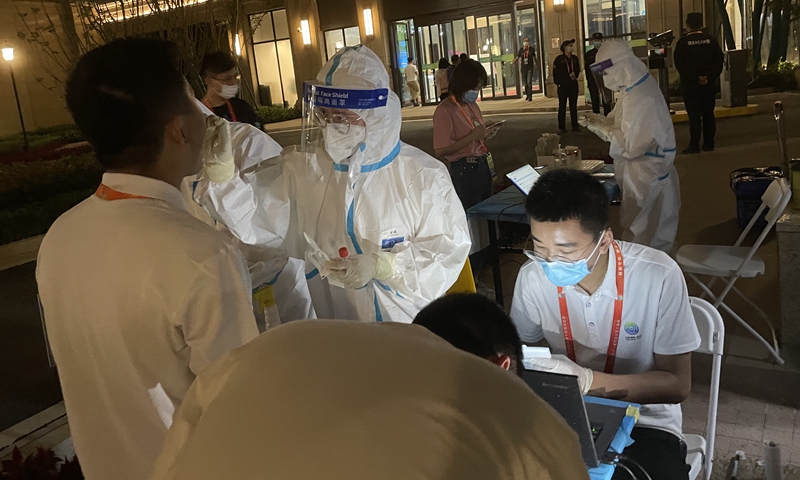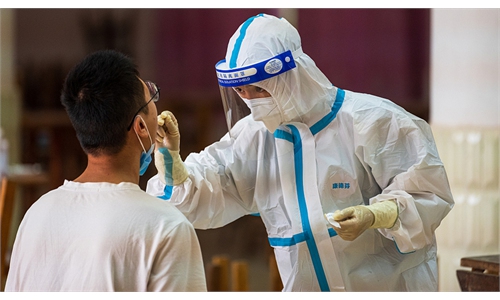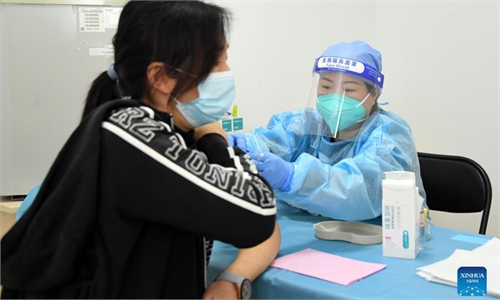7 seniors in cross-provincial tour group test positive, prompting fears of extended transmission chain

Nucleic acid testing in Xi'an File photo: Wang Qi/GT
Fears have grown that chain of transmission may further extend after seven elderly people in a cross-provincial tour group tested positive for COVID-19. The group, which departed from Shanghai, traveled to Gansu, Inner Mongolia and Shaanxi. Relevant local governments have scrambled to track down their close contacts and test related personnel.
The Xi'an government announced on Monday morning that it will carry out city-wide nucleic testing at any time with reagents, materials and personnel to be fully deployed, after seven elderly people including three couples traveled to the city from Shanghai, all of whom have tested positive for COVID-19.
The first two cases discovered in Shaanxi involve a couple from Shanghai surnamed Yan (wife) and Jiang (husband) aged 62 and 65, respectively. They left Shanghai by airplane for Zhangye city in Northwest China's Gansu and transferred planes in Xi'an in Shaanxi on October 9.
Between October 9 and 15, they took a road trip in Gansu and the Inner Mongolia Autonomous Region.
Fears mounted that the chain of transmission may be extended, after six confirmed local infections (including the Shanghai couple) and one asymptomatic carrier in Shaanxi Province. The patients are all in their 60s and 70s, and they all departed together from Shanghai and traveled together in a group.
There was also another confirmed infection in Yinchuan in Northwest China's Ningxia Hui Autonomous Region, as reported on Monday morning. The case in Yinchuan, surnamed Ai, is a close contact of the Shanghai couple, who he met on October 9. They then traveled together to Gansu between October 10 and 15.
The local epidemic prevention and control authority in Suining, Southwest China's Sichuan Province, has been tracking down a close contact of the Shanghai couple since Sunday. The close contact surnamed Li traveled from Jiayuguan to Xi'an on October 15 on the same flight with the Shanghai couple. Jiayuguan city in Northwest China's Gansu Province launched city-wide nucleic acid tests from 8 am on Monday.
The high-risk group (the elderly) and cross-provincial tours are the main elements that led to the extended transmission chain in the outbreak, according to experts.
A thorough epidemiological investigation is urgently needed to determine the origin of the cases and their relationship, Wang Guangfa, a respiratory expert at Peking University First Hospital, told the Global Times on Monday.
The epidemiological investigation should also find out whether these people were vaccinated. "The outbreak reminded us that the vaccines may alleviate or even eliminate the clinical symptoms of COVID-19, which can cause some infections to be neglected," Wang said.
The cold weather in winter is also more suitable for the virus' survival, Wang explained, stressing that people should follow strict personal protection measures even if they've been vaccinated and take nucleic acid tests promptly.
As of Sunday, more than 2.23 billion doses of COVID-19 vaccines had been administered in China, according to the National Health Commission. Meanwhile, many places across the country are already rolling out booster shot campaigns.
Shaanxi province reportedly started providing booster shots on Monday and Shanghai also started the service recently.
The overall epidemic prevention and control strategy has not changed, with an emphasis placed on the detection and control of imported cases at ports, prompt epidemiological investigation and clearing of cases in a timely manner. This is the lesson that we learned from the achievements we have made in epidemic control, Wang said.
In terms of whether the sporadic cases over the weekend will turn into a new resurgence, more observations and epidemiological investigations are needed, according to Wang.


